Christmas in the Barn
By Margaret Wise Brown; Illustrated by Diane Goode
We have a barn, so this book is really relatable and imaginative territory for me as I wonder what it was really like on that Christmas Eve thousands of years ago.
Some have said this blessed event occurred in a stable, some say a cave or, even here, written by the author of the famous “Good night Moon,” and illustrated by Caldecott Award winning illustrator Diane Goode, it occurs in a barn.
Somehow, I think Mary and Joseph did not have the cozy comfort of this idyllic setting for the birth of their baby. Ms. Goode’s images are of a snowy wind whipped day, with a couple, on the cusp of a birth, trying to find shelter for the night.
But no matter, the setting here is an “ancient barn”, set apart from the main house where the owners, apparently kindly though unseen, take in two out-of-towners on a bitterly cold, snow drifted night, as they await the birth of their child.
The couple are drawn by Ms. Goode as ordinary folk, caught unawares in a defining moment in their lives. And Ms. Wise Brown makes the nativity story fresh, accessible and real to readers. This could be any couple, awaiting the birth of their baby.
Was it that way more than 2,000 years ago in Bethlehem? Maybe. But I think the freshly new straw laden ancient barn with its coziness is what we may all hope it could have been in an ideal world and in our imaginations.
But, all the truly essential elements are there in this re-imagining of this seminal moment in Christian history.
The “ancient barn,” for that is the one thing that defines the measure of age, and its ability to sustain against the onslaught of time, is set in a huge, snow covered field. Its lintels house the couple-in-waiting who “had lost their way,” plus a host of out-of-door curious creatures, including rabbits, a black and white herd dog, horses, and even field mice, escaping the frigid temperatures.
And, also, all the traditionals are here: the sheep, cow, cattle, oxen and donkey are present front and center. Did I miss the “doves in the rafters high?”
And there they were all safe and warm
All together in that ancient barn.
Young readers will love how the positioning of the shepherds, a stones throw away in a nearby pasture, come running with one small cry:
When hail – the first wail of a newborn babe reached the night
Where one great star was burning bright
Where are the wise men, kids may ask? Not to worry. They arrive at the dawn of Christmas Day.
And interestingly enough, their look is not defined in any way, as if it were not important, as they are just there in shadow, a trio to bear witness and manifest that moment in time to a wider world.
All together
In that ancient barn
Margaret Wise Brown’s re-imagining of the story is wonderful in setting, in tone, and in the texture of its simplicity in the farm-like images of Diane Goode’s pastoral art.
Maybe what young readers may glean from this ancient story, positioned in an “ancient barn”, is that a miracle occurring some 2,000 years ago is still possible to reverberate today, in the kindness we make visible in the world, as this centuries old event continues to echo its tidings of joy to young readers of today, and down the ages.
Ninja Baby Written by David Zeltser Illustrated by Diane Goode . . .Chronicle Books 11/01/2015 . . 978-1-4521-3542-7 . . 32 …
DIANE GOODE has illustrated 55 beloved and critically acclaimed picture books, including the New York Times best seller, FOUNDING MOTHERS and the Caldecott Honor Book, WHEN I WAS YOUNG IN THE MOUNTAINS.
By Nicki Richesin, The Children’s Book Review
Published: October 12, 2011
Looking for some spooky good reads this Halloween? Below is our family’s list of all-time favorites. Have a Happy Halloween!
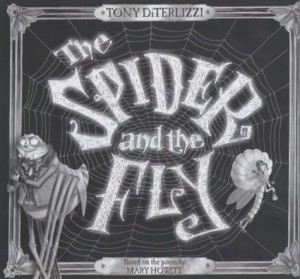 A cautionary tale from 1829 The Spider and the Fly will capture your children’s imagination. Tony DiTerlizzi spins a masterful retelling of Mary Howitt’s poetic fable with his perversely charming pictures. It’s such fun and best read with a wicked voice… Ba ha ha ha ha! (Ages 6-9)
A cautionary tale from 1829 The Spider and the Fly will capture your children’s imagination. Tony DiTerlizzi spins a masterful retelling of Mary Howitt’s poetic fable with his perversely charming pictures. It’s such fun and best read with a wicked voice… Ba ha ha ha ha! (Ages 6-9)
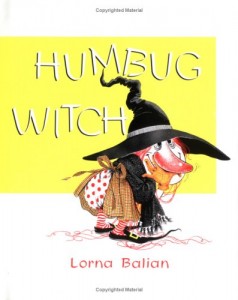 Humbug Witch is a little witch who can’t quite fly her broom or make her cauldron boil and bubble, but Lorna Balian’s surprise ending will delight your little ones. (Ages 3-8)
Humbug Witch is a little witch who can’t quite fly her broom or make her cauldron boil and bubble, but Lorna Balian’s surprise ending will delight your little ones. (Ages 3-8)
Diane Goode’s Book of Scary Stories & Songs is a fabulous collection of old folktales, poems, and songs that will either send a shiver down your spine or make you laugh out loud. Goode’s playful illustrations bring old favorites back to life like “The Ghost of John” and “The Green Ribbon.” (Ages 5-8)
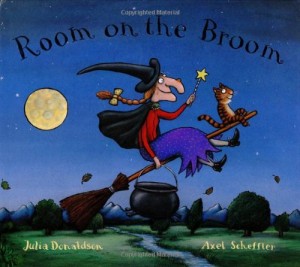 From the creators of The Gruffalo, zooms Room on the Broom. Julia Donaldson tells the story of this enterprising witch and cat. Young children will become bewitched by the rhyme and have a silly time. (Ages 4-8)
From the creators of The Gruffalo, zooms Room on the Broom. Julia Donaldson tells the story of this enterprising witch and cat. Young children will become bewitched by the rhyme and have a silly time. (Ages 4-8)
The Witches’ Supermarket is a terribly clever book for ages 4-8 who will enjoy being one step ahead of the little girl in disguise who shops for all manner of shocking grocery items (like apples with worms and shake n’ bake snake) with her faithful dog. (Ages 5-8)
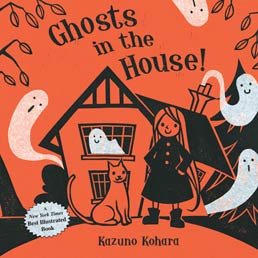 Ghosts in the House become repurposed by the new owner as lovely curtains, tablecloths and comforters. Decorating her cozy home with Kazuno Kaharo’s simple yet charming illustrations, kids might just want to move in. (Ages 3-6)
Ghosts in the House become repurposed by the new owner as lovely curtains, tablecloths and comforters. Decorating her cozy home with Kazuno Kaharo’s simple yet charming illustrations, kids might just want to move in. (Ages 3-6)
You’ll probably have to check your local library for copies of Adrienne Adams classic Halloween books
Cinderella Smith didn't get her nickname because she has a wicked stepmother (hers is "just a regular kind of mom who is usually nice but kind of strict.") or because she has mean stepsisters (Tess, her younger sister, is a sweetheart) or because she sleeps next to an ashy fireplace or because she has tons of chores to do. No, Cinderella earned her name because she's always losing shoes. In the course of the story, she misplaces half-a-dozen. Most find their way back to her, except for the one she needs most of all--her brand-new ruby red tap shoe. Without it, she won't be able to dance the coveted lead part of Pumpkin Blossom Fairy in the Autumn Recital.
Luckily, this Cinderella, unlike her fairy-tale namesake, has plenty of pluck, and doesn't require a fairy godmother to solve her problems. Instead she teams up with the new girl in school, Erin, who has her own worries. Her mother is remarrying and she's getting two stepsisters. Will they be mean or nice? Cinderella is all set to help her new friend find out.
First-time author
Stephanie Barden successfully juggles both plot lines, putting her young heroine into one scrape after another. Diane Goode's wriggly line drawings capture Cinderella's bouncy, exuberant personality to a tee. A second book,
Cinderella Smith and the More the Merrier, will come out next year. Yippee!
Cinderella Smith
by Stephanie Barden
illustrations by Diane Goode
HarperCollins, 160 pages
Published: 2011
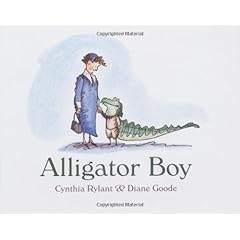 Alligator Boy by Cynthia Rylant, illustrated by Diane Goode. Harcourt, Inc. $16.00
Alligator Boy by Cynthia Rylant, illustrated by Diane Goode. Harcourt, Inc. $16.00
I imagine that it must be the nicest thing in the world to have a collaborator with whom you’ve worked for twenty odd years or so. How comforting that must be. The pairing of author Cynthia Rylant and illustrator Diane Goode began long long ago when they first worked together to create “When I Was Young In the Mountains”. Badda bing, it wins a Caldecott Honor and the rest is history. I wasn’t aware that the two were still doing any shared projects, and then this lovely little book arrived on my desk. “Alligator Boy” is a small simple picture book that goes against expectations beautifully. If you happen to be in desperate need of a book that will delight your small children, boys and girls alike, but that falls on the understated side of the equation, I cannot recommend this story enough. Charming, charming, charming.
After taking a trip to a museum and seeing a life-sized stuffed alligator in all its reptilian glory, a young boy decides that becoming an alligator is his life’s goal. His aunt, who hears this wish over the phone, is happy to help the kid live his dream and sends him an easily worn alligator head and tail. Though his father is fine with the change, his mother worries about his health and a vet (the doctor wouldn’t come) is quickly dispatched. But as it turns out, there’s nothing wrong with the little alligator, so it’s off to school he goes. And wouldn’t you know it but it’s the best thing that’s ever happened to him. Now he can do everything the other kids can, but he’s also adept at scaring away the school bully and rescuing dogs from dogcatchers. The last image in the book is of the little alligator, tuckered out at the end of a long day, sitting sleepily and happily on his loving mother’s lap.
Now when I read this story I full expected the boy to tire of his gatorial garb at some point in the proceedings so as to learn a rote lesson. Perhaps he’d find that people didn’t trust him as much or that he scared kittens. Then he’d go back to being a boy and we’d get some twist ending where he starts wearing a panda outfit on the last page. This is the standard procedure that a whole heckuva lot of picture books follow, and it’s deathly deadly dull. How much more interesting then to find that the boy wants to be an alligator, becomes one, and is then accepted by friends and family alike. The last image in this book is of the boy snuggled contentedly on his mother’s lap, seemingly without a care in the world. Now, I don’t like to read too much into a book, but this is a picture book that’s going to speak to a lot of people on a lot of different levels. For anyone who has ever felt that they were born in the wrong body and want to change their appearance drastically, this is the perfect gift of a book. This title also struck me as a subtle (and better illustrated) follow-up to Charlotte Zolotow’s, “William’s Doll”. Basically, it's about accepting someone for being what they want to be. Yet unlike those didactic children’s stories out there, this tale is sweet enough that the message (if indeed there is one at all) goes down so smoothly you won’t even realize you’ve learned it until a great deal of time has passed. Kudos to Ms. Rylant then for her good taste.
Of course, equal consideration/congrats/rose petals should be thrown at Ms. Diane Goode. Over the years Ms. Goode has pared down her style to its essential elements. In this story you’ve picture created with line on paper alongside watercolors and gouache. The color palette is a comfortable series of greens, blues, and serene (though certainly NOT pastel) shades and tones. As for the characters themselves, Goode places them in an abundant amount of white space. She knows how to show them off. To let them stand and pose and prance about without cluttering up the images. Yet for all this simplicity, she also conveys some very tender and dear emotions. Cleverly, the alligator head is able to show the emotions of the boy inside of it. And aside from his human hands and legs, you might begin to believe (as the kid himself undoubtedly does) that he really is an alligator incarnate. Now Ms. Goode chose to set this story in a time that never existed, which is rather interesting to look at. By the clothing, you might think that this story took place in the early 20th century (maybe the 30s). Heck, the bully in the book (who proves easy enough to frighten) wears a soft cabbie hat and blue suit. All the boys are in short pants, all the girls are in dresses, and the teacher is prone to a bow tie or two when he feels the yen. On the flip side, this is a fully multicultural books. The vet is black, the schoolmates are all sorts of ethnicities, and there’s even a girl in a wheelchair in one of the scenes. So while this is a time and place in world history that probably never happened, you’ll come to wish that it had.
Ah, but I did have one objection to this book and I’m afraid it deals with the choice to make this a rhyming text. It’s always a dangerous decision on any author’s part. Now by and large and for the most part Rylant does very well by her words. “His days were quite happy, his days were a joy . . . / What a good green life for an alligator boy.” That’s all well and good. Unfortunately, there are times when the rhymes don’t scan. “He found his dear dad and told him the story / of being a lizard, no longer a boy.” Now insofar as I can tell, that’s supposed to rhyme. The entire book is ABABAB. Um… this line doesn’t. Also there is the brief moment of awkwardness here and there. “She asked a good doctor to come and to see / this boy who could not a boy now be.” Doesn’t scan all that well and it’s doggone difficult to say properly aloud.
Quibbles aside, I have a very special place in my heart for this book. Really, it belongs in the same camp as “Imogene’s Antlers” by David Small. By sheer coincidence, it also is coming out in the same year as Emily Jenkins’, “Daffodil, Crocodile”, about a little girl who dresses up in a crocodile head to distinguish herself from her sisters. But where “Daffodil, Crocodile” is madcap and crazed, “Alligator Boy” is small and quiet and supremely sublime. A fantastic book for one-on-one sharing and a great story for any kid who has ever wished to take their dressing up to an entirely different level.
On shelves June 1, 2007









